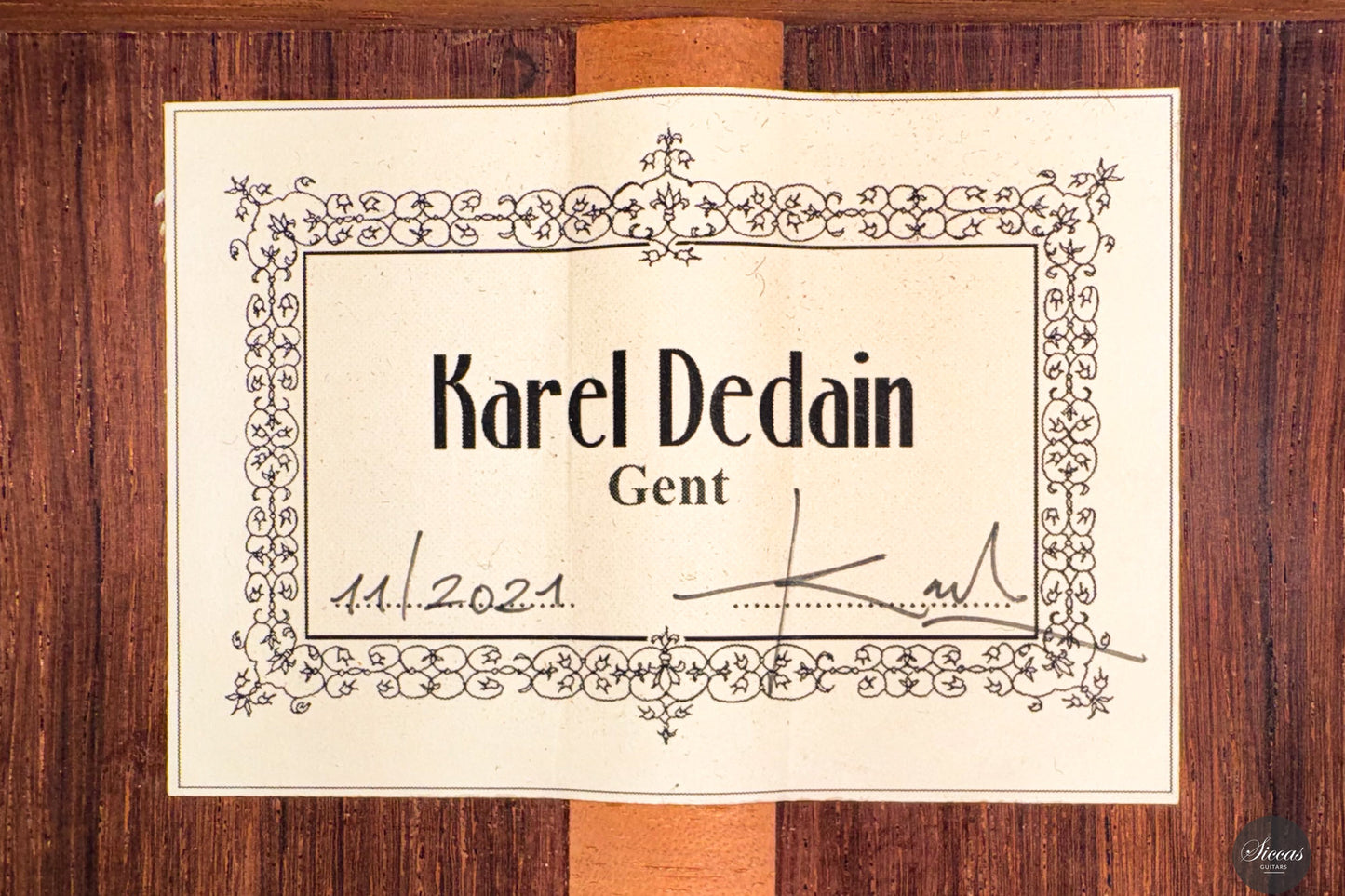Karel Dedain - 2021
Karel Dedain - 2021
Details
Details
Overview
Overview
Shipping important note
Shipping important note
Delivery times are typically reliable and most instruments arrive within the estimated timeframe.
Should any unexpected delay occur, our team will keep you informed and provide support at every step. For all shipping details and exceptions, please see our Shipping Policy.
Details about GPSR
Details about GPSR
























Video overview


More details about the guitar
About the luthier
Karel Dedain, born in 1976, built his first guitar in 1998. He lives and works in Ghent, Belgium. His passion for playing flamenco guitar led to a deeper interest in instrument making, which he pursued through formal training at the CMB (Centrum voor Muziekinstrumentenbouw) under Walter Verreydt. Since 2006, he has been building guitars full-time and specializes in both classical and flamenco models. Karel also teaches guitar making alongside Walter Verreydt at the Centre for Musical Instrument Making in Puurs, Belgium. He builds around ten guitars per year, each one completely handmade. Shellac polishing is one of his key specialties. His approach to lutherie is not to reinvent tradition but to draw from the most successful ideas of historic makers such as Torres, Garcia, Arias, and Hernandez to create instruments of beauty and depth.About the guitar
This 2021 guitar by Karel Dedain exemplifies the essence of expert craftsmanship, blending traditional techniques with tonewoods of the highest quality to deliver a remarkable musical instrument. It features a spruce soundboard supported by seven fan braces, and the back and sides are made of Madagascar rosewood, contributing not only to the visual elegance of the instrument but also to its lush, resonant sound. The result is a guitar with a highly desirable combination of balance, depth, and responsiveness, an ideal choice for serious players seeking tonal sophistication and precision.Condition
This guitar is used but in mint condition, showing only very subtle and minimal marks that are not easy to spot.Regular care extends the life of the instrument
Even with careful use, a classical guitar may gradually change in appearance or respond to unstable storage conditions. Have a close look at your guitar regularly and be attentif to changes. If your instrument is suffering from its environement, it will let you know.
Protect Your Guitar: Handle with Care
Be mindful when touching your instrument with greasy or unwashed hands: any skin contact is a small attack on the varnish. Of course, a guitar is made to be played, but taking a few precautions helps preserve its beauty: wash your hands before playing, wear long sleeves, and avoid unnecessary direct skin contact with the body of the instrument.
Pro tip: Avoid playing with a button-up shirt, heavy jewelry, or a belt, as these can scratch the guitar. Also, make sure your guitar case is free of any objects that could damage the instrument during storage.
String care
A good habit to adopt is wiping down your strings briefly after each playing session. This small action significantly extends their lifespan and helps maintain a consistent, comfortable feel under your fingers.
Most importantly, clean strings are essential for keeping your instrument in tune. Corrosion, sweat, and dust can affect the uniformity of the strings and interfere with accurate tuning across the entire fingerboard.
Pro tip: If you're having trouble getting your guitar in tune, it might be time to change the strings. A useful test is to compare the pitch of the 12th fret harmonic with the fretted note at the 12th fret; if there's an unusually large gap between them, your strings may have lost their integrity and should be replaced.
Keep Your Shellac Finish Shining!
Got a guitar with a shellac (French polish) finish? Here's a simple trick: Take a clean microfiber cloth and gently breathe on the surface to create a light mist. Then, softly rub to remove fingerprints, sweat, and grease. That’s usually all it takes to keep it looking great, no products needed!
Pro tip: Every few years, treat your guitar to a check-up with a luthier to keep it in top shape.
Storing Your Guitar: Climate Matters
Your guitar can safely stay outside its case, as long as the surrounding environment maintains 42–55% humidity and a temperature between 18–25°C.
Keep in mind that humidity levels can still fluctuate inside the case, especially during seasonal changes.
- Too much humidity may cause overtightened strings and a dull tone.
- Too little humidity can lead to a bulging top, string buzz, or even cracks.
Avoid placing your guitar near radiators, air conditioners, or windows with direct sunlight.
Pro tip: Always close your guitar case while playing. This helps preserve a stable microclimate inside the case, so your instrument is protected the moment you put it back in.



















































